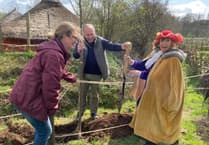A SPARK of colour has been brought to the dull grey hoardings in front of Petersfield Museum as it undergoes redevelopment, thanks to a piece of artwork created by pupils of Petersfield Infant School.
The mural, which is made up from 256 individually decorated squares, is based on the school logo and depicts a child in both Victorian and modern school uniform.
The artwork was designed by Petersfield Museum’s engagement team assistant Lauren Wayland.
She said: “Being a museum, we were keen to show the history of the Victorian school while also connecting its pupils to today.”
The tiles were decorated by pupils in Years 1 and 2 during special workshop sessions run by the museum.
The project has been a real team effort, with the building contractor Phoenix Construction Services supplying and preparing the materials as well as erecting the finished artwork.
Petersfield Museum’s engagement team officer, Ryan Watts, said: “The museum is always looking to work with community groups, schools, societies and organisations and get them involved with us.
“It has been great working with Petersfield Infant School and we hope to continue our close relationship into the future.”
It is hoped that once the artwork comes down it will find a new home within the school.
Headteacher Allyson Crew said: ‘’The whole school is intrigued by what is going on behind the hoardings and we just can’t wait to take a peek inside once work is completed.
"We are so incredibly lucky to have such an amazing resource right on our doorstep and look forward to forging many new links with the museum in the future.”
Members of the school council from Years 1 and 2 took a short walk along St Peter’s Road to see their finished artwork in place outside the museum.
The pupils were very excited by what they saw, with comments including “there are no words,” “it’s out of this world” and “amazing.”
Work to bring the museum into the 2020s took it back to medieval times last year, when the stone walls of a cellar were found during foundations work for new galleries.
Archaeologist George Anelay assessed the discovery and believes it belongs to one of a row of houses shown on a map of 1775 which were pulled down at some point before 1806.




